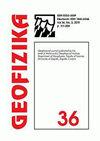Earthquakes of 1838 and 1839 in the Slovene Hills (Slovenia)-Međimurje (Croatia) area
IF 0.9
4区 地球科学
Q4 GEOCHEMISTRY & GEOPHYSICS
引用次数: 1
Abstract
Analyses of available data (newspaper reports, historical and church chronicles, chronical earthquake overviews, travel books, monographies, research papers, etc.) on effects of the earthquakes that shook the greater Ormož area at the Slovenian-Croatian border in the 1838 and 1839 revealed that one of them, recorded in a number of regional and global catalogues, is in fact a fake - the earthquake of 26 August 1838 never happened. This error creeped into various reports and studies, and then into many relevant catalogues, so this event should by systematically erased from the catalogues used to estimate seismicity rates in the neighbourhoods of north-western Croatia, north-eastern Slovenia, and south-western Hungary.Regarding the earthquake of 31 July 1838, we used important new sources of information that have not been consulted in any previous study. This made inversion of macroseismic parameters more robust. Our estimates of the macroseismic moment magnitude (Mwm = 4.8) is mostly higher than the values reported in the available catalogues. Reliable information on the effects of the smaller event of 22 March 1839 were found for two localities only, so its epicentre was placed into the town of Ormož where the maximum intensity was observed. Its estimated moment magnitude (Mwm) is close to the median of values found in the six consulted catalogues that listed this event.The macroseismic epicentre of the 1838 earthquake lies close to the junction of surface traces of the Donat strike-slip fault and the reverse Čakovec fault. Based on their assumed geometry and the location of the macroseismic hypocentre, we give slight preference to the Donat fault as the seismogenic source.1838年和1839年斯洛文尼亚山(斯洛文尼亚)-Međimurje(克罗地亚)地区的地震
对1838年和1839年斯洛文尼亚-克罗地亚边境大奥尔莫日地区地震影响的现有数据(报纸报道、历史和教会编年史、历史地震综述、旅游书籍、专著、研究论文等)的分析表明,其中一项记录在多个地区和全球目录中,事实上是假的——1838年8月26日的地震从未发生过。这一错误蔓延到各种报告和研究中,然后蔓延到许多相关的目录中,因此应系统地将这一事件从用于估计克罗地亚西北部、斯洛文尼亚东北部和匈牙利西南部社区地震活动率的目录中删除。关于1838年7月31日的地震,我们使用了以前任何研究都没有参考过的重要的新信息来源。这使得宏观地震参数的反演更加稳健。我们对宏观地震矩震级(Mwm=4.8)的估计大多高于现有目录中报告的值。关于1839年3月22日较小事件影响的可靠信息仅在两个地区发现,因此震中位于观测到最大强度的奥尔莫日镇。其估计的矩震级(Mwm)接近列出该事件的六个参考目录中的中值。1838年地震的宏观震中靠近Donat走滑断层和Čakovec逆断层表面痕迹的交界处。根据它们假设的几何形状和宏观震源的位置,我们略微倾向于将多纳特断层作为发震源。
本文章由计算机程序翻译,如有差异,请以英文原文为准。
求助全文
约1分钟内获得全文
求助全文
来源期刊

Geofizika
地学-地球化学与地球物理
CiteScore
1.60
自引率
0.00%
发文量
17
审稿时长
>12 weeks
期刊介绍:
The Geofizika journal succeeds the Papers series (Radovi), which has been published since 1923 at the Geophysical Institute in Zagreb (current the Department of Geophysics, Faculty of Science, University of Zagreb).
Geofizika publishes contributions dealing with physics of the atmosphere, the sea and the Earth''s interior.
 求助内容:
求助内容: 应助结果提醒方式:
应助结果提醒方式:


